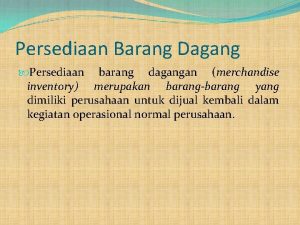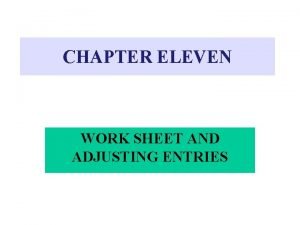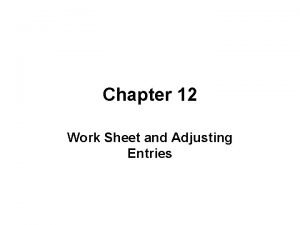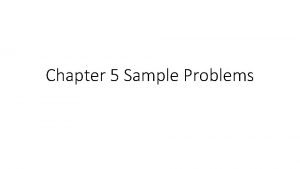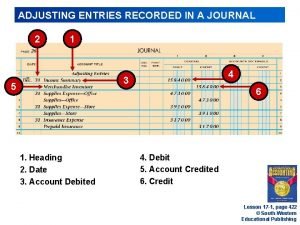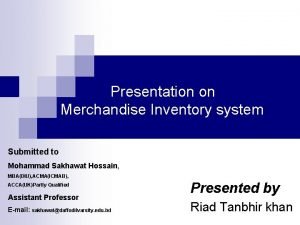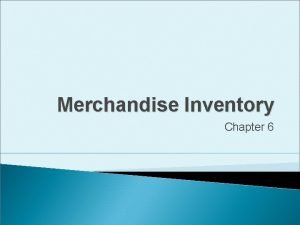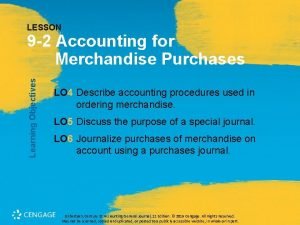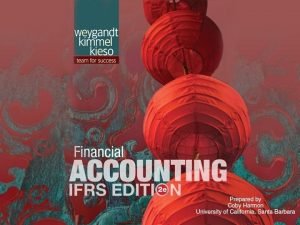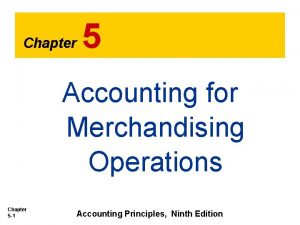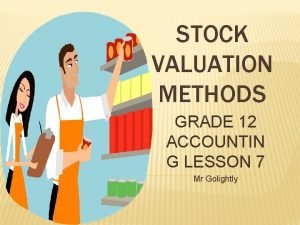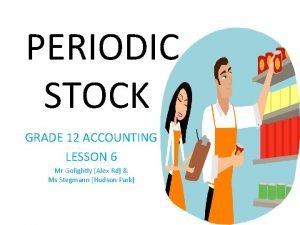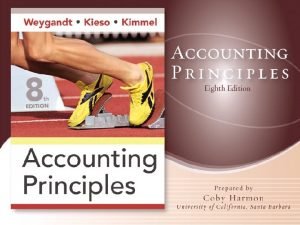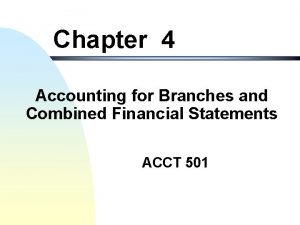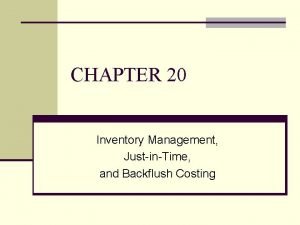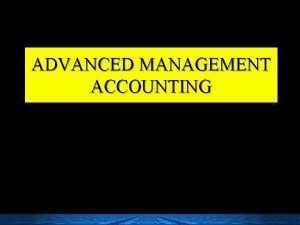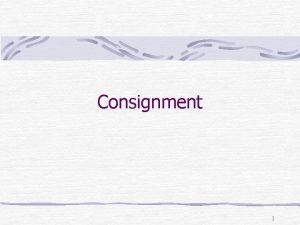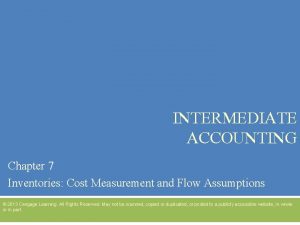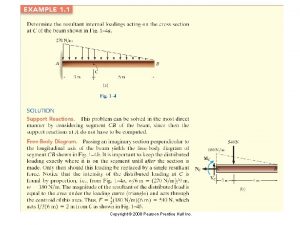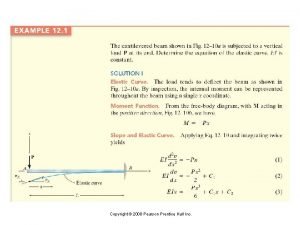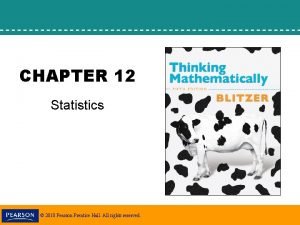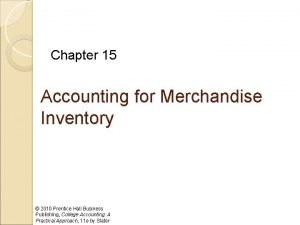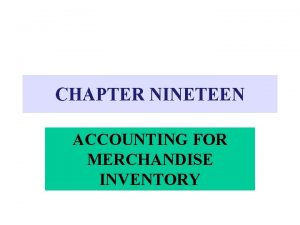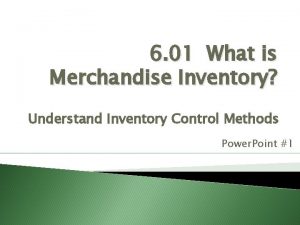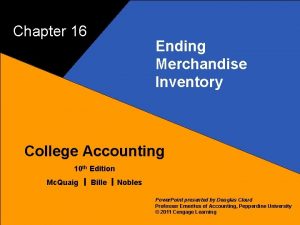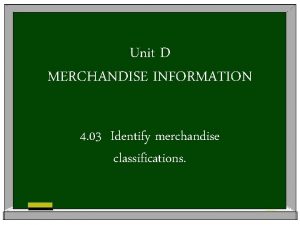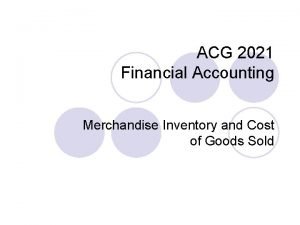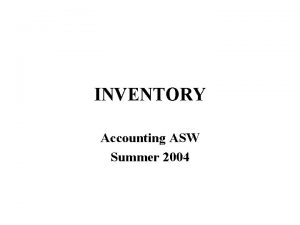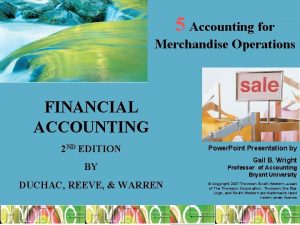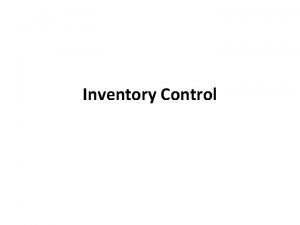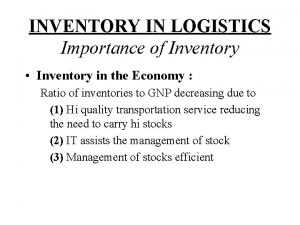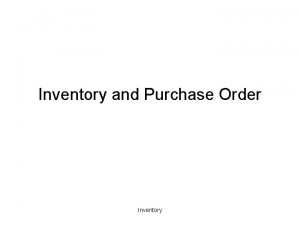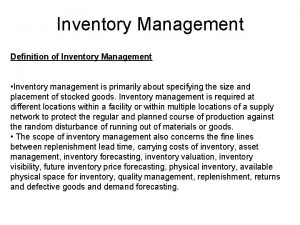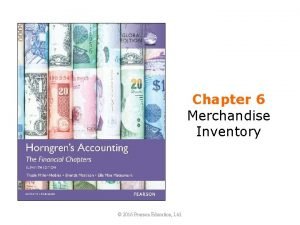Accounting for Merchandise Inventory Chapter 15 2004 Prentice



























- Slides: 27

Accounting for Merchandise Inventory Chapter 15 © 2004 Prentice Hall Business Publishing, College Accounting: A Practical Approach, 9 e by Slater 15 - 1

Learning Objective 1 Understanding and journalizing transactions using the perpetual inventory system, and explaining the difference between perpetual and periodic inventory system. © 2004 Prentice Hall Business Publishing, College Accounting: A Practical Approach, 9 e by Slater 15 - 2

Learning Unit 15 -1 (Perpetual Inventory System) Merchandise Inventory Cost of Goods Sold © 2004 Prentice Hall Business Publishing, College Accounting: A Practical Approach, 9 e by Slater 15 - 3

Learning Unit 15 -1 (Perpetual Inventory System) The inventory debit balance is the up-to-date cost of inventory on hand. Purchased 10 software packages at a cost of $25 per package. © 2004 Prentice Hall Business Publishing, College Accounting: A Practical Approach, 9 e by Slater 15 - 4

Learning Unit 15 -1 (Perpetual Inventory System) Merchandise Inventory 250 Accounts Payable 250 To record the purchase of inventory Inventory 250 Accounts Payable 250 © 2004 Prentice Hall Business Publishing, College Accounting: A Practical Approach, 9 e by Slater 15 - 5

Learning Unit 15 -1 (Perpetual Inventory System) As goods are sold, the cost of the goods are debited to the Cost of Goods Sold account and credited to the Inventory account. © 2004 Prentice Hall Business Publishing, College Accounting: A Practical Approach, 9 e by Slater 15 - 6

Learning Unit 15 -1 (Perpetual Inventory System) Debit Cash or Accounts Receivable Credit Sales Revenue Debit Cost of Goods Sold Credit Merchandise Inventory © 2004 Prentice Hall Business Publishing, College Accounting: A Practical Approach, 9 e by Slater 15 - 7

Learning Unit 15 -1 (Perpetual Inventory System) Sold three packages for cash for $150. Accounts Receivable 150 Sales Revenue Cost of Goods Sold 75 Merchandise Inventory 150 75 © 2004 Prentice Hall Business Publishing, College Accounting: A Practical Approach, 9 e by Slater 15 - 8

Learning Unit 15 -1 (Perpetual Inventory System) Debit Inventory Credit Cost of Goods Sold (For the cost of the goods returned by customer) Debit Sales Returns & Allowances Credit Cash (For the sales price of the goods returned) © 2004 Prentice Hall Business Publishing, College Accounting: A Practical Approach, 9 e by Slater 15 - 9

Learning Unit 15 -1 (Perpetual Inventory System) Debit Accounts Payable Credit Inventory (For the cost of the goods returned to the supplier) © 2004 Prentice Hall Business Publishing, College Accounting: A Practical Approach, 9 e by Slater 15 - 10

Learning Unit 15 -1 (Perpetual Inventory System) The perpetual system gives a day-to-day picture of sales and the cost of goods sold. The periodic system shows the proper balance in inventory at year end only. © 2004 Prentice Hall Business Publishing, College Accounting: A Practical Approach, 9 e by Slater 15 - 11

Learning Objective 2 Maintaining a subsidiary ledger for inventory. © 2004 Prentice Hall Business Publishing, College Accounting: A Practical Approach, 9 e by Slater 15 - 12

Learning Unit 15 -2 (Using a Subsidiary Ledger) Accounting for inventory items becomes complicated as soon as product lines expand. Subsidiary ledgers are necessary to properly track inventory items. Daily posting (or instant recording through electronic computerized systems) allow managers easy access to information. © 2004 Prentice Hall Business Publishing, College Accounting: A Practical Approach, 9 e by Slater 15 - 13

Learning Unit 15 -2 (Using a Subsidiary Ledger) A-I-B Software Date Purchased Sold Balance 6/2 10 @ $250 6/3 3 @ $25 $175 6/5 1 @ $25 $200 6/6 1 @ $25 $175 © 2004 Prentice Hall Business Publishing, College Accounting: A Practical Approach, 9 e by Slater 15 - 14

Learning Unit 15 -2 (Using a Subsidiary Ledger) Item: VX 113 Received Sold Balance Cost per per Date Units Unit Total 1/01 FWD 14 50 $ 700 Balance 1/12 2 50 100 12 50 600 1/19 10 60 600 12 50 10 60 1, 200 1/25 8 50 400 4 50 10 60 800 © 2004 Prentice Hall Business Publishing, College Accounting: A Practical Approach, 9 e by Slater 15 - 15

Learning Objective 3 Understanding periodic methods of determining the value of the ending inventory. © 2004 Prentice Hall Business Publishing, College Accounting: A Practical Approach, 9 e by Slater 15 - 16

Learning Unit 15 -3 (Periodic Inventory System) Specific invoice FIFO LIFO Weighted average © 2004 Prentice Hall Business Publishing, College Accounting: A Practical Approach, 9 e by Slater 15 - 17

Learning Unit 15 -3 (Specific Invoice Method) Goods Available for Sale Calculating Cost of Ending Inventory Units Cost Total 01/01 Beg. Inv. 10 $100 03/15 Purch. 9 12 108 08/18 Purch. 20 13 260 11/15 Purch. 5 15 75 44 $543 Units Cost Total Cost of goods available for sale Less: Cost of ending inventory = Cost of goods sold 6 6 $12 13 12 $ 72 78 $150 $543 150 $393 © 2004 Prentice Hall Business Publishing, College Accounting: A Practical Approach, 9 e by Slater 15 - 18

Learning Unit 15 -3 (FIFO Method) Goods Available for Sale Calculating Cost of Ending Inventory Units Cost Total 01/01 Beg. Inv. 10 $100 03/15 Purch. 9 12 108 08/18 Purch. 20 13 260 11/15 Purch. 5 15 75 44 $543 Cost of goods available for sale Less: Cost of ending inventory = Cost of goods sold Units Cost 7 5 12 $13 15 Total $ 91 75 $166 $543 166 $377 © 2004 Prentice Hall Business Publishing, College Accounting: A Practical Approach, 9 e by Slater 15 - 19

Learning Unit 15 -3 (LIFO Method) Goods Available for Sale Calculating Cost of Ending Inventory Units Cost Total 01/01 Beg. Inv. 10 $100 03/15 Purch. 9 12 108 08/18 Purch. 20 13 260 11/15 Purch. 5 15 75 44 $543 Cost of goods available for sale Less: Cost of ending inventory = Cost of goods sold Units Cost 10 $10 2 12 Total $100 24 12 $124 $543 124 $419 © 2004 Prentice Hall Business Publishing, College Accounting: A Practical Approach, 9 e by Slater 15 - 20

Learning Unit 15 -3 (Weighted-average Method) Goods Available for Sale Units Cost Total 01/01 Beg. Inv. 10 $100 03/15 Purch. 9 12 108 08/18 Purch. 20 13 260 11/15 Purch. 5 15 75 44 $543 Cost of goods available for sale Less: Cost of ending inventory = Cost of goods sold $543 ÷ 44 = $12. 34 (weighted-average cost per unit) 12 rakes × $12. 34 = $148. 08 $543. 00 148. 08 $394. 92 © 2004 Prentice Hall Business Publishing, College Accounting: A Practical Approach, 9 e by Slater 15 - 21

Learning Unit 15 -3 (Cost of Inventory Inclusions) Goods in transit: Add to inventory if the ownership of the inventory has been transferred to the buyer. Merchandise on consignment: This is not included in the cost of inventory. Damaged or obsolete merchandise: If it is not saleable, it should not be included in the cost of inventory. If saleable, add to the cost of inventory at a conservative figure. © 2004 Prentice Hall Business Publishing, College Accounting: A Practical Approach, 9 e by Slater 15 - 22

Learning Objective 4 Estimating ending inventory using the retail method and gross profit method and understanding how the ending inventory amount affects financial reports. © 2004 Prentice Hall Business Publishing, College Accounting: A Practical Approach, 9 e by Slater 15 - 23

Learning Unit 15 -4 (Estimating Ending Inventory) Goods available for sale: Beginning inventory Net purchases Cost of goods available for sale Cost ratio, $12, 000 ÷ $20, 000 = 60% Net sales at retail Inventory at retail Ending inventory at cost, $6, 000 ×. 60 Cost $ 4, 100 7, 900 $12, 000 Retail $ 6, 900 13, 100 $20, 000 14, 000 $ 6, 000 $ 3, 600 © 2004 Prentice Hall Business Publishing, College Accounting: A Practical Approach, 9 e by Slater 15 - 24

Learning Unit 15 -4 (Estimating Ending Inventory) Goods available for sale: Inventory, January 1, 20 xx Net purchases Cost of goods available for sale Less: Estimated cost of goods sold: Net sales at retail $6, 000 Cost percentage (100% – 30%). 70 Estimated cost of goods sold Estimated inventory, January 31, 20 xx $10, 000 4, 000 $14, 000 4, 200 $ 9, 800 © 2004 Prentice Hall Business Publishing, College Accounting: A Practical Approach, 9 e by Slater 15 - 25

Learning Unit 15 -4 (Effect on Financial Reports) If the Item is Overstated Understated Beginning inventory Ending inventory Profit is understated Profit is overstated Profit is understated © 2004 Prentice Hall Business Publishing, College Accounting: A Practical Approach, 9 e by Slater 15 - 26

End of Chapter 15 © 2004 Prentice Hall Business Publishing, College Accounting: A Practical Approach, 9 e by Slater 15 - 27
 Contoh “merchandise inventory”
Contoh “merchandise inventory” Adjusting entries merchandise inventory
Adjusting entries merchandise inventory Weighted average inventory costing method
Weighted average inventory costing method Adjusting entries for merchandise inventory
Adjusting entries for merchandise inventory Suppose dave's discount merchandise inventory
Suppose dave's discount merchandise inventory Adjusting entries for inventory
Adjusting entries for inventory Merchandise inventory meaning
Merchandise inventory meaning Define merchandise inventory
Define merchandise inventory A form requesting the purchase of merchandise
A form requesting the purchase of merchandise Sales discount perpetual inventory system
Sales discount perpetual inventory system Chapter 5 accounting for merchandising operations
Chapter 5 accounting for merchandising operations Financial accounting and accounting standards chapter 1
Financial accounting and accounting standards chapter 1 Inventory valuation grade 12
Inventory valuation grade 12 Periodic inventory system grade 11
Periodic inventory system grade 11 Inventory in the balance sheet
Inventory in the balance sheet Branch balance sheet
Branch balance sheet Backflush costing
Backflush costing Economic order quantity formula
Economic order quantity formula Consignee account
Consignee account Inventory intermediate accounting
Inventory intermediate accounting What is an ode
What is an ode Copyright 2008
Copyright 2008 2008 pearson prentice hall inc
2008 pearson prentice hall inc 2008 pearson prentice hall inc
2008 pearson prentice hall inc Copyright 2005 pearson prentice hall inc
Copyright 2005 pearson prentice hall inc Pearson prentice hall
Pearson prentice hall Prentice hall inc
Prentice hall inc Prentice hall careers
Prentice hall careers
